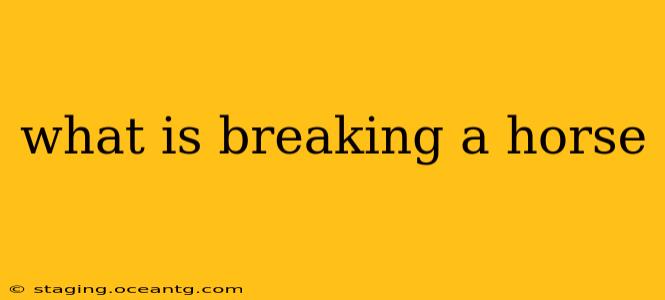"Breaking a horse" is a term that evokes strong images, often conjuring up harsh and outdated methods. However, the reality is more nuanced. The phrase itself is becoming increasingly outdated, as the modern understanding of equine training emphasizes a gentler, more collaborative approach. What was once understood as "breaking" a horse is now more accurately described as starting or training a horse. This crucial distinction reflects a fundamental shift in how we interact with these intelligent animals.
What are the traditional methods of "breaking" a horse?
Traditional methods, often associated with the term "breaking," frequently involved harsh techniques designed to subdue the animal's will. These could include:
- Severe bitting: Using harsh bits to control the horse's mouth, potentially causing pain and injury.
- Forced flexion: Forcing the horse into unnatural positions, causing discomfort and potentially leading to physical problems.
- Isolation and deprivation: Keeping the horse in stressful environments to break its spirit.
- Rough handling and intimidation: Using fear and physical dominance to control the horse.
These methods, while effective in gaining immediate control, often resulted in:
- Fear and distrust: The horse learns to associate humans with pain and negativity.
- Physical damage: Injuries to the mouth, back, and legs can be common.
- Psychological trauma: The horse may develop behavioral issues such as aggression or anxiety.
These older methods are increasingly recognized as inhumane and ineffective in creating a safe and willing partner.
What are the modern, humane methods of starting a horse?
Modern horse training emphasizes building a positive relationship between horse and handler based on trust, respect, and clear communication. These methods prioritize:
- Positive reinforcement: Rewarding desired behaviors with treats, praise, and release of pressure.
- Desensitization: Gradually introducing the horse to new stimuli and experiences in a calm and controlled manner.
- Clear communication: Using body language and consistent cues to guide the horse.
- Patience and understanding: Recognizing that each horse learns at its own pace and requires individual attention.
These modern methods lead to:
- A willing partner: The horse learns to trust and cooperate with the handler.
- A strong bond: The relationship between horse and handler is based on mutual respect.
- A happy and healthy horse: The horse is less likely to develop behavioral or physical problems.
What does starting a horse involve?
Starting a horse usually involves a multi-stage process, gradually introducing the horse to various elements of riding:
- Groundwork: Establishing basic obedience and trust through groundwork exercises. This includes teaching the horse to lead, yield to pressure, and accept a saddle and bridle.
- Saddling and bridling: Gently introducing the horse to the saddle and bridle, ensuring comfort and minimizing stress.
- Mounting and dismounting: Teaching the horse to stand still while being mounted and dismounted.
- Basic riding: Gradually introducing the horse to the basics of riding, such as walking, stopping, and turning. This often involves long reins and lunging to develop balance and coordination before proper riding begins.
How long does it take to start a horse?
The time it takes to start a horse varies considerably depending on the horse's temperament, prior experiences, and the training methods used. It can range from several weeks to several months. The focus should always be on the horse's well-being and progress, not on speed.
Is there a difference between starting a horse and breaking a horse?
The difference between starting and breaking a horse is profound. "Breaking" implies subduing the horse's spirit through forceful methods. "Starting" emphasizes a collaborative partnership built on trust and understanding, prioritizing the horse's well-being and creating a positive learning environment.
What is the best way to start a horse?
The best way to start a horse is through patient, positive reinforcement, combined with a solid understanding of equine behavior and communication. It's crucial to seek guidance from experienced and reputable trainers who use humane and effective methods. Never attempt to start a horse without professional guidance, especially if you lack experience.
This shift in terminology and methodology reflects a growing awareness of equine welfare and a commitment to building respectful partnerships with these magnificent animals. The days of "breaking" a horse should be long gone, replaced by a more compassionate and effective approach to starting and training.
